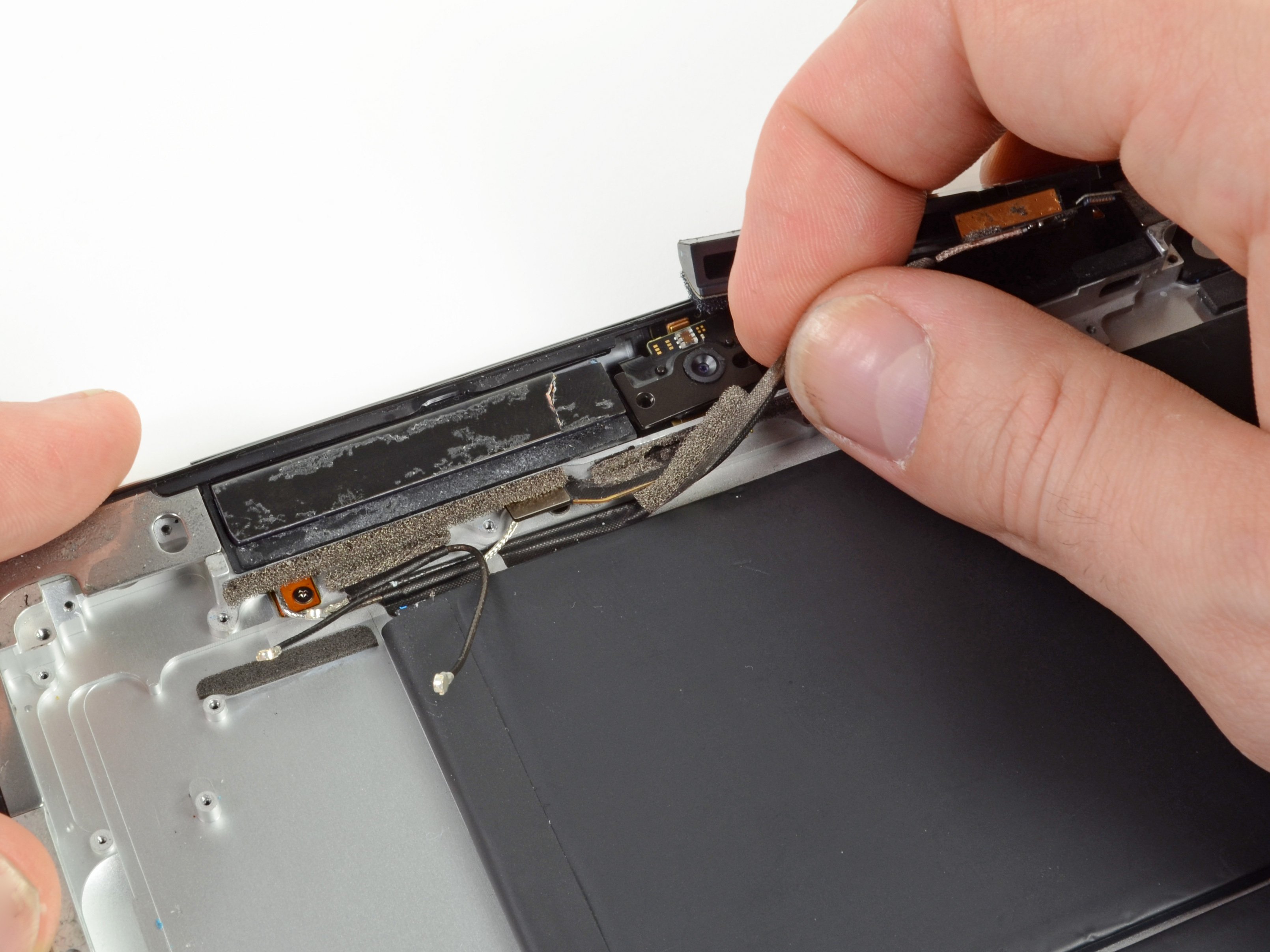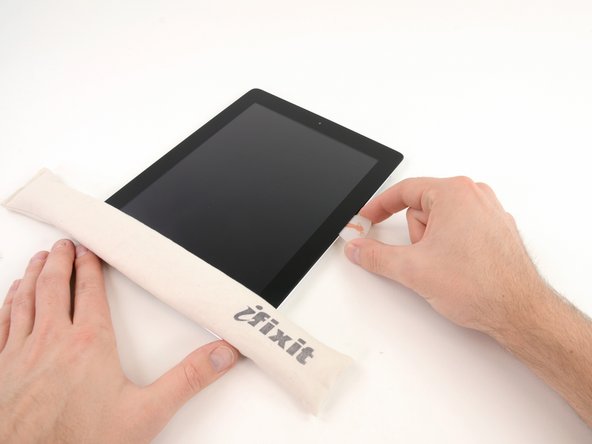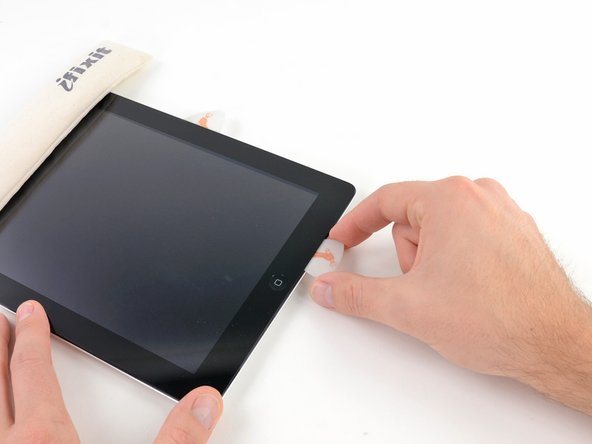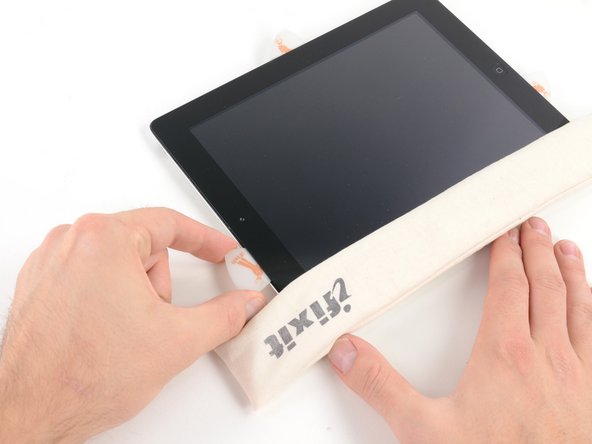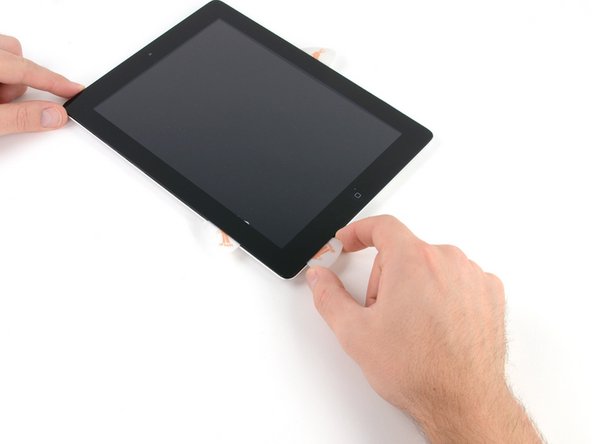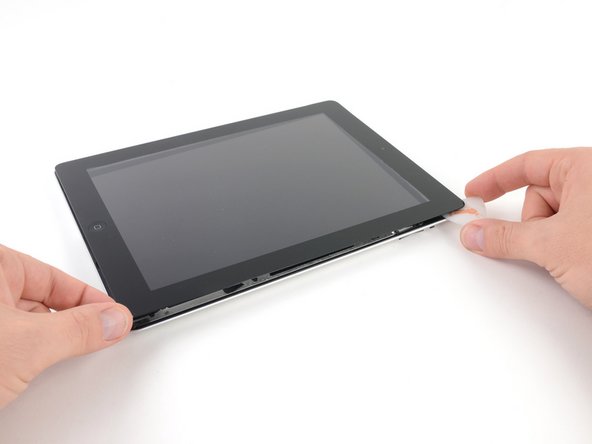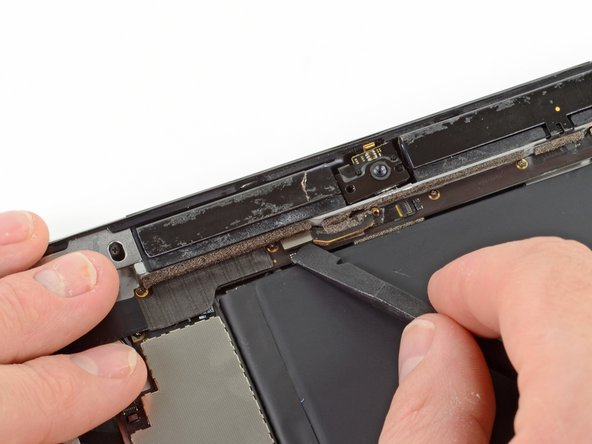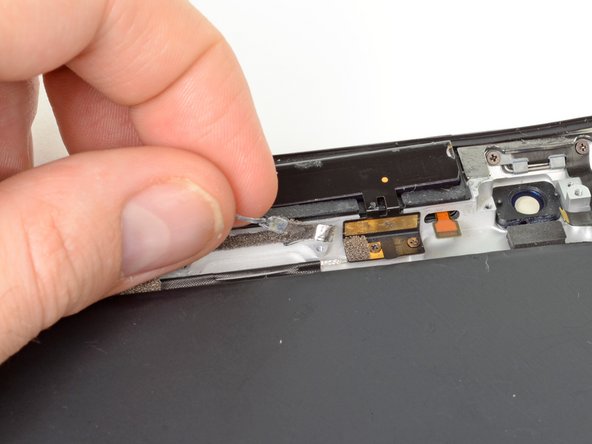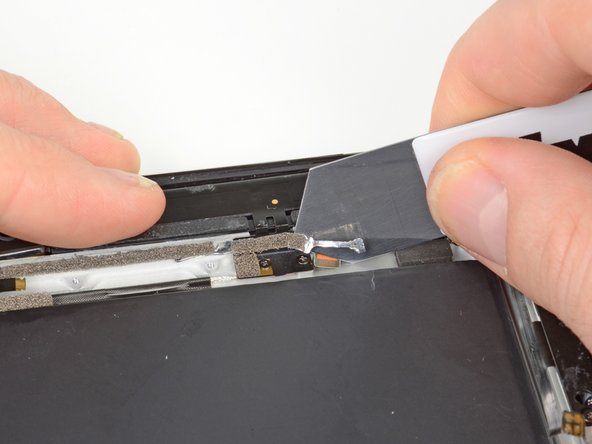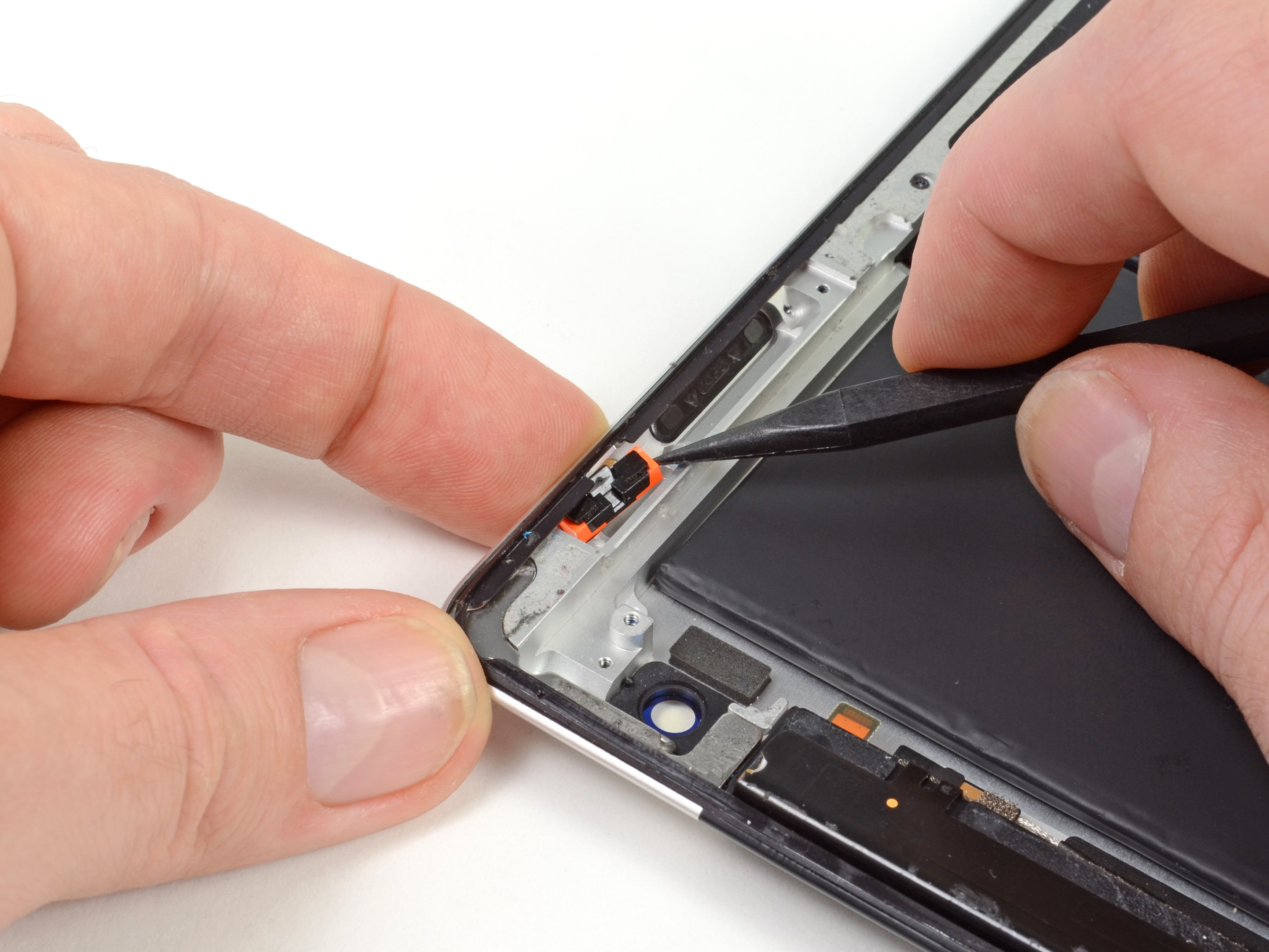iPad 3 4G Right Cellular Data Antenna Replacement
Duration: 45 minutes
Steps: 62 Steps
Ready to swap out the right antenna? Follow along and we'll get your device back in signal-shape in no time!
Step 1
For carousel microwaves: Ensure that the plate can spin without any hiccups. If your iOpener gets trapped, it could overheat and cause a burn. Stay cool and keep things moving!
Give your microwave a quick wipe-down first—no one wants leftover gunk tagging along on the iOpener adventure.
- Pop the iOpener right in the middle of your microwave like a pro!
Tools Used
Step 2
Take care not to get the iOpener too hot during your repair. Heating it past 100˚C (212˚F) could cause it to pop—definitely not what we want!
If the iOpener looks puffy or swollen, keep your hands off—it’s time to retire that one.
If the iOpener is still too warm to handle in the center, keep using it gently while it cools down a bit before heating it again. When heated just right, it’ll stay cozy for about 10 minutes.
Microwave wattage varies, so adjust your heating time accordingly. Your iOpener is ready when it’s just a tad too hot to touch—perfectly toasty!
- Pop that iOpener in the microwave for thirty seconds to get it nice and toasty!
- As you work through the repair, remember to reheat the iOpener in the microwave for another thirty seconds whenever it starts to cool down.
Tools Used
Step 3
Watch out! The iOpener is going to be super toasty, so handle it with care. If it's too hot to handle, grab an oven mitt for some extra protection!
- Carefully take the iOpener out of the microwave, gripping it by one of the flat ends to keep your hands safe from the steamy center.
Tools Used
Step 4
Caution: The iOpener is going to be quite toasty! Make sure to handle it only by the end tabs to keep your fingers safe and sound.
No microwave? No problem! Just pop that iOpener in some boiling water for a cozy heat-up.
- Grab a pot or pan and fill it with enough water to fully cover your iOpener.
- Bring the water to a boil, then turn off the heat—no need to keep it bubbling.
- Drop your iOpener into the hot water and let it soak for 2-3 minutes, making sure it’s completely submerged.
- Carefully fish out the warm iOpener using tongs.
- Give it a good dry-off with a towel so it’s ready to roll.
- Your iOpener is all set! If it cools down, just heat the water again to a boil, turn off the heat, and dunk the iOpener for another 2-3 minutes.
Tools Used
Step 5
- Grab a SIM eject tool or an unbent paperclip and gently pop that SIM tray out like a pro!
Step 6
- Gently slide the SIM tray out of its cozy little spot and set it free from your iPad.
- If you're swapping out the SIM card, just pop it out of its tray and slide in the new one like a pro!
Step 7
Pop on some safety glasses to keep your eyes safe, and handle that LCD screen with care — it’s delicate!
This helps keep those sneaky glass shards from flying everywhere and strengthens the screen while you carefully pry and lift it.
- Got a cracked display glass? No worries! Grab some tape to keep those pesky shards contained and avoid any accidental pokes while you work your magic.
- Start by layering some clear packing tape over your iPad's display like you're frosting a cake—overlapping those strips until the entire face is covered.
- Now, as you dive into the rest of the guide, just a heads up: once that glass starts to break, it might keep on cracking. If that happens, a metal prying tool can help you scoop out the pieces. You're doing great—keep it up!
Step 8
Heads up! Since you might be dealing with some sneaky shards of broken glass here, it’s a smart move to pop on some safety glasses to keep your eyes safe and sound.
- Place the iOpener flat along the right edge of the iPad, pressing it down so it makes solid contact with the surface.
- Give it about 90 seconds to work its magic before you try opening up the front panel.
Tools Used
Step 9
Getting the opening tool wedged between the glass and plastic might take a bit of elbow grease. Take your time, and gently wiggle the plastic tool back and forth until it slips in nicely.
- Check out the tiny gap in the iPad's adhesive ring located in the upper right corner, about 2.0 inches (~5 cm) down from the top edge. This little opening is your secret entry point.
- Line up your tool with the mute button. Gently slip the tip of a plastic opening tool into the narrow space between the front glass and the plastic bezel. Just a little tip insertion is enough to start prying the crack open.
Step 10
- Be sure to slide that tool right into the sweet spot—nestled between the plastic display bezel and the front panel glass. You've got this!
Step 11
- Keep the tip of your plastic opening tool tucked between the front glass and plastic bezel, then slide a plastic opening pick right into that gap, just next to the tool. Easy does it!
Step 12
- Gently pull out the plastic opening tool from the iPad, then slide the opening pick a bit deeper under the front glass—aim for about half an inch. Keep it smooth and steady!
Step 13
- As you work on loosening the adhesive on the right side of the iPad, give the iOpener another heat-up and set it back on the bottom edge of the iPad.
Tools Used
Step 14
This adhesive is super strong, and you might need to put in some elbow grease. Take your time and be gentle!
If you spot the tip of the opening pick sneaking out from under the front glass, gently pull it back just a bit. While having the pick this deep won’t cause any harm, it might leave some adhesive smudges on the LCD.
- While the bottom edge is soaking up some heat from the iOpener, let’s get the party started by releasing the adhesive from the right edge of the iPad.
- Gently slide your trusty opening pick down along the edge of the iPad, peeling away that adhesive like a pro!
Tools Used
Step 15
As you peel away the adhesive, you might find it handy to pop that heated iOpener back onto the iPad's right edge. This little move can be a game changer, especially if your iPad has had a bit of time to cool off while you were busy working your magic.
- If your opening pick gets stuck in the sticky adhesive, try 'rolling' it gently along the edge of the iPad to keep loosening that glue and make progress!
Tools Used
Step 16
- Before you pull that first opening pick from the bottom corner of the iPad, slide a second pick under the right edge of the front glass to keep the adhesive from sticking back together.
- Heat up the iOpener again and move it to the top edge of the iPad to loosen things up nicely.
Tools Used
Step 17
The Wi-Fi antenna is snugly secured to the bottom right corner of the iPad's rear case with screws and a cable. Given the positioning of the Wi-Fi antenna, it's super important to handle this step with care—otherwise, you might accidentally cause some permanent damage to the antenna. Let's keep it safe and sound!
- Heads up: the next steps need you to be extra careful.
- You’ll need to gently loosen the adhesive holding the antenna to the front panel without messing with the delicate connections at the bottom of the iPad. Take it slow and follow along closely.
Step 18
Heads up! Don’t push the pick past the bottom right corner or you might accidentally mess up the Wi-Fi antenna.
- Gently slide the opening pick around the bottom right corner of the iPad to loosen the adhesive hiding there.
Step 19
Careful now! Slide that opening pick along the bottom right edge of the front panel, but watch out—the Wi-Fi antenna hangs tight near the corner and could get sliced if you’re not gentle with the adhesive.
Don’t pull the pick all the way out from under the front glass—just wiggle it out a bit so about 1/8" (3 mm) of the tip stays tucked underneath.
- Gently glide the tip of the opening pick along the bottom edge of the iPad, freeing up the adhesive that's holding the Wi-Fi antenna in place. You're doing great!
Step 20
- After you’ve passed the Wi-Fi antenna (about 3" or 75 mm in from the right edge, right next to the home button), slide the opening pick all the way back in.
- Gently slide the pick to the right to free up the adhesive holding the Wi-Fi antenna to the front glass.
- The antenna is secured to the bottom of the iPad with screws and a cable. This step makes sure the antenna stays safe and sound when you lift the front panel.
Step 21
Keep your iOpener chill—heat it for no more than a minute at a time, then let it cool down for at least two minutes before giving it another warm-up.
If the adhesive has gotten a bit too chilly along the bottom edge, give the iOpener a quick reheat to warm things up where you're working your magic.
- Keep sliding the opening pick under the bottom edge of the iPad, carefully looping it around the home button. Once you’re past the home button, pop the pick back in about half an inch (10 mm) deep to keep that adhesive release going.
Tools Used
Step 22
Heads up! When working on iPad 4 models, gently slide the pick in only up to 1/2 inch (10 mm) here to keep that home button ribbon cable safe and sound.
- Keep peeling the adhesive carefully all along the bottom edge of the iPad.
- Leave the opening pick snugly tucked under the front glass close to the home button.
Step 23
- Warm up your iOpener in the microwave and place it on the left edge of the iPad. This will help get that adhesive nice and toasty in that area!
Tools Used
Step 24
If your adhesive has decided to cool off a bit too much, just swap out the iOpener for a fresh one along the top edge and keep going! And if the iOpener itself has gotten a little too chill, give it a quick reheat and get back to business!
- Gently slide the opening pick along the top edge of your iPad, giving it a little tug to navigate around the front-facing camera bracket.
- This section has some pretty strong adhesive, so you might need to put in a bit of elbow grease. Take your time and be careful—no one wants to harm themselves or their precious iPad!
- If the opening pick feels like it's caught in the sticky stuff, try giving it a little roll, just like we showed in step 9.
Tools Used
Step 25
If the adhesive feels warm enough, go ahead and take the iOpener off the iPad to make things easier. But if it’s still a bit sticky, just heat up the iOpener again and keep it on the left edge while you keep working.
- Keep peeling away the sticky stuff along the top edge of your iPad, and gently slide that opening pick around the top left corner like you’re making a smooth turn on a dance floor.
Tools Used
Step 26
Heads up! The digitizer cable hangs out about 2" (50 mm) from the bottom edge of your iPad. When sliding your pick, pause the moment you hit around 2.25" (60 mm) from the bottom to avoid any oops moments.
- Gently slide the opening pick along the left edge of your iPad, letting it do its magic to release the adhesive as you go. The adhesive is a bit shy here, thanks to the digitizer that runs along the entire left side. Just a friendly reminder: keep that pick shallow (no deeper than 1/2 inch or 10 mm) to avoid any mishaps with the digitizer. You've got this!
Step 27
Heads up! The bottom of the digitizer cable is just about an inch (25 mm) from the iPad's bottom edge. Take it slow and steady to make sure you don’t accidentally snip this little guy.
- Grab that trusty opening pick you've got tucked under the bottom edge of your iPad. Now, let's gently free the adhesive that's holding things together in the bottom left corner. You've got this!
Step 28
Sometimes the adhesive around the edge of your iPad decides to stick back down like it never left. When that happens, gently slide a pick under the spot where the front glass is still holding on tight, and carefully 'cut' through the adhesive to free it up.
- Grab one of those trusty opening picks and gently wedge it under the bottom right corner of your iPad, then lift it up enough to get a good grip with your fingers.
Step 29
Watch out for any sticky stuff that might still be clinging on! Grab an opening pick and gently slice through any adhesive that's keeping the front panel in place. You've got this!
- Grab your iPad by the top and bottom right corners, and gently twist the front glass away from the device like you're opening a treasure chest.
- When it's time to put everything back together, take a microfiber cloth and some compressed air to give the LCD a nice clean-up, removing any pesky dust or fingerprints before sealing it up with the glass.
Step 30
- Go ahead and remove those four 2 mm Phillips #00 screws that are holding the LCD snugly to the aluminum frame. You've got this!
Step 31
Handle the LCD with care, folks! That ribbon cable is as delicate as a butterfly's wing and could snap if you bend it too much. Keep it safe and sound!
- Grab a plastic opening tool or a spudger and gently lift the right edge of the LCD from the iPad. No rush, just take it slow and steady.
- Now, rotate the LCD along its left edge and carefully place it on top of the front panel. It's like flipping a pancake, but way more rewarding!
Tools Used
Step 32
- Carefully use the tip of your spudger to lift the tape that’s hiding the LCD ribbon cable connector underneath.
Tools Used
Step 33
- Gently lift the little flap on the LCD ribbon cable's ZIF connector — it's like opening a tiny door for your cable to slide out.
- Carefully wiggle the LCD ribbon cable free from its socket on the logic board using your fingers or some tweezers, no heavy lifting required.
- If your iPad refuses to wake up after reconnecting the LCD, do a quick force restart by holding the power and home buttons for around ten seconds until the Apple logo shows up — like giving it a little nudge. If things still don’t light up, you can always schedule a repair.
Step 34
- Carefully lift the LCD away from the front panel without making any contact with the screen. You've got this!
Step 35
- Gently use the tip of your spudger to lift and peel back the tape holding the touchscreen ribbon cable to the logic board—slow and steady wins the race!
Tools Used
Step 36
- Lift up the little retaining flap on both of the ZIF connectors for the touchscreen ribbon cable. It's a simple move, but it sets you up for success!
Step 37
- Gently wiggle the flat end of your spudger to pry up the adhesive holding down the digitizer ribbon cable.
- Carefully pull the digitizer ribbon cable straight out from its connectors on the logic board.
Tools Used
Step 38
- Gently lift the touchscreen ribbon cable and grab your trusty spudger. Use the flat end to carefully break free the adhesive that's holding the cable snugly against the rear aluminum case. You've got this!
Tools Used
Step 39
- Gently coax that touchscreen ribbon cable out of its cozy spot in the aluminum frame using just your fingers. It’s a bit like giving it a little nudge to come out and play!
- Now, let's go ahead and detach the front panel from the iPad. Think of it as peeling off a sticker, only way cooler!
Step 40
- Gently peel back and remove the strip of electrical tape hiding the headphone jack assembly cable connector.
- With the tip of your trusty spudger, carefully lift the little retaining flaps on both ZIF connectors that hold the headphone jack cable onto the logic board.
Tools Used
Step 41
- Gently slide the flat end of a spudger under the headphone jack assembly cable. You’ll want to carefully lift it free from the adhesive that’s holding it to the rear aluminum frame.
- Once that's done, pull the headphone jack assembly cable out of its socket on the logic board. It should come right out without too much fuss.
Tools Used
Step 42
- Gently peel back and remove the tape that’s protecting the SIM board cable ZIF connector.
- Flip up the little flap holding the SIM board cable ZIF connector in place.
- Carefully use the tip of a spudger to pull the SIM board cable straight out from its socket on the logic board.
Tools Used
Step 43
- Unscrew those three tiny 1.75 mm Phillips #00 screws that are holding the SIM board snugly against the aluminum frame. You've got this!
Step 44
Gently slide the headphone jack assembly cable aside—pulling too hard might just send the headphone jack flying off!
- Carefully hold the headphone jack assembly cable out of the way, then go ahead and remove the SIM board from the iPad.
Step 45
- Gently lift and peel off the sticky tape that’s keeping the headphone jack assembly snug and secure.
Step 46
- Unscrew the lone 2.6 mm Phillips #0 screw holding the camera cable onto the headphone jack assembly—easy does it!
Step 47
- Gently use the flat end of your spudger to lift the front-facing camera off its socket on the headphone jack assembly.
- Keep the spudger in place and slide it to the right to loosen the adhesive holding the camera cable down.
Tools Used
Step 48
- With the spudger's tip, gently lift the retaining flap on the microphone cable ZIF connector.
- Carefully slide the spudger under the microphone ribbon cable to detach it from its ZIF connector.
- Now, glide the spudger to the left to break the adhesive that’s holding the microphone ribbon cable to the headphone jack assembly.
Tools Used
Step 49
- Gently slide the flat end of the spudger under the antenna connector cable and lift it out of its cozy home on the headphone jack assembly board. You're doing great!
Tools Used
Step 50
- Gently lift the little flap that’s holding down the volume and power button ribbon cable connector on the headphone jack assembly board.
- Carefully slide the volume button ribbon cable out of its ZIF connector.
Step 51
These screws are tilted into the aluminum frame, so make sure to position your screwdriver in line with the screw. This will help you avoid stripping it and keep everything on track!
- Time to get those screws out of the headphone jack assembly. Grab your tools and follow along:
- Five 2.6 mm Phillips #0 screws – they're the ones that like to hide, so be thorough!
- Two 2.2 mm Wide Head Phillips #00 screws – they’re slightly smaller, but don’t let that fool you.
- Two 2.6 mm Phillips #00 screws – yep, more of the same size as the first batch, just to keep things interesting.
Step 52
- Gently grab the ribbon cable connected to the headphone jack assembly. With care, slide the assembly straight down towards the bottom of the device, keeping it parallel to the iPad. Easy does it—no need to rush.
Step 53
- Hold the headphone jack assembly firmly with both hands and carefully pull it out from the iPad, keeping an eye out for any cables that might be hanging around.
Step 54
If you spot any electrical tape on the Wi-Fi antenna, speaker cable, or dock connector cable, go ahead and peel it off carefully to keep things moving.
Step 55
Carefully pry from underneath the connector, not the socket itself. Prying on the socket can cause some seriously bad damage—nobody wants that!
- Carefully unplug the following connectors from their spots on the logic board:
- Wi-Fi antenna cable
- Speaker connector cable.
- Dock connector cable.
Step 56
- Unscrew the seven screws holding the logic board to the back aluminum panel.
- Six 2.1mm Phillips #00 screws
- One 2.5mm Phillips #00 screw
Step 57
- Carefully flip the logic board over, watching out for any cables that might want to play tug-of-war.
- Gently use the tip of a spudger to pop off the three antenna connectors from their spots on the logic board.
Tools Used
Step 58
As you peel off that EMI tape from the cable, remember to slide the iSesamo in between the tape and the cable, not between the cable and the shiny aluminum housing. Keep it smooth and easy!
- Gently slide the tip of your iSesamo or the edge of a plastic opening tool under the metal EMI tape that’s snugly covering the antenna cable. Time to peel that tape away with a bit of finesse!
Step 59
- Grab your trusty Phillips #00 screwdriver and remove the two 1.75 mm screws holding that antenna in place on the aluminum frame. It’s like a little screw treasure hunt—just a couple more to go!
Step 60
- Use your fingers or a spudger to gently lift the antenna out of its socket, rotating it downward to clear the space.
- Double check that the orange ribbon cable smoothly slides through its designated hole in the aluminum frame.
Tools Used
Step 61
- Take your trusty spudger and gently slide the flat end under the adhesive tape that's holding the antenna cable in place on the aluminum frame.
- Once you're under there, give the cable a little nudge to the left to free it from the adhesive.
Tools Used
Step 62
- Now that you've tackled the disassembly, it's time to put everything back together! Just reverse the steps and you'll be all set. If you run into any tricky spots, remember, you can always schedule a repair for some extra help!
